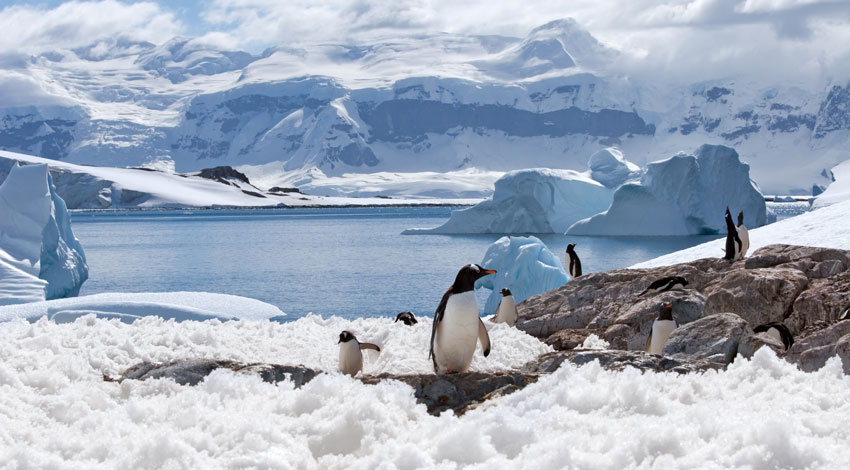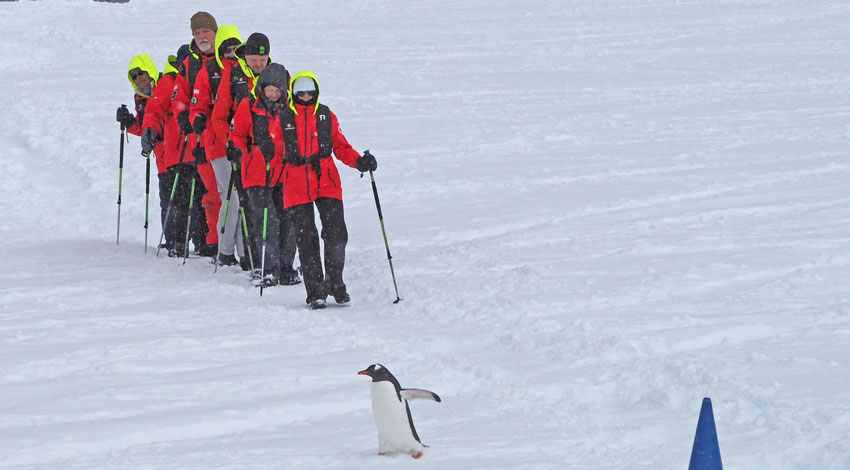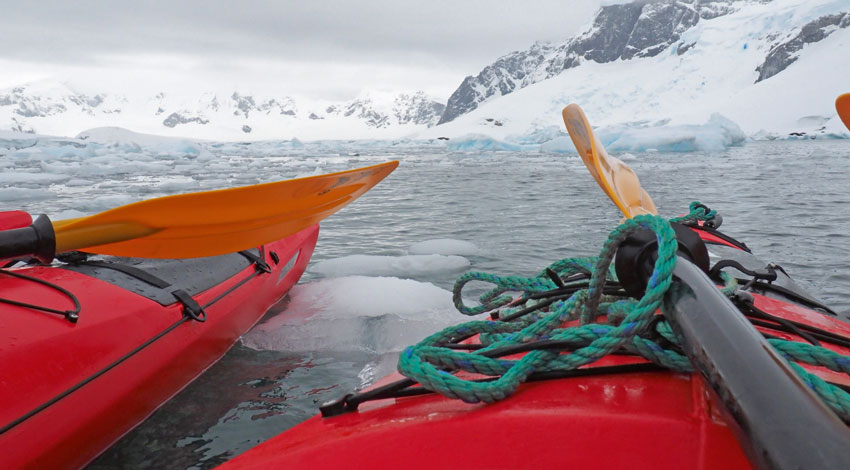Antarctica Packing List - What To Pack for Antarctica?
Are you planning a trip to Antarctica soon? Thinking of traveling to the frozen continent but not sure what to expect? We’re experts on Antarctica because we work with the best Antarctica cruise ships and offer so many ways to go. We have tips and info on what to put on your Antarctica packing list (hint: you will need a separate cruise packing list), what to wear, and everything you need to know for your Antarctic adventure

How cold will it be in Antarctica?
Probably warmer than you expect! Most people who travel to Antarctica will visit between November and March, which are the warmest months on the continent, and most visitors won’t go past the Antarctic Peninsula and nearby islands. Though the actual South Pole is prone to temperatures below zero Fahrenheit, summer temperatures on the peninsula usually hover somewhere around 32 °F (0 °C).
What will the weather be like in Antarctica?
Just like anywhere you travel, you can’t predict the weather. Antarctica has some of the strongest winds on the planet. Plan for wind, rain and snow with waterproof and windproof outer layers. Also, the ozone layer over the continent is thin, so the sun can be powerful. Be sure to pack your sunscreen, even for cloudy days.
Do I need to be in shape to go to Antarctica?
Because Antarctica is so remote, most ships* will require you to submit a signed form from your doctor proving that you’re healthy enough to make the trip, and you should be sure to bring an ample supply of medications. Physical activities and excursions will vary for each departure.* Some easier options are usually available most days (like tender boat cruises to see wildlife and icebergs and landings that include easier walks or exploring) as well as more challenging hiking options some days. As long as you’re healthy enough to travel, board a tender boat and walk up to a mile, there should be enough to keep you busy!*
How long will it take to get to Antarctica?
Your journey will likely begin with a long flight (or two) to Buenos Aires. It’s nice to spend an overnight there to break up the trip, and Road Scholar includes a pre- and post-night at a city hotel on most of our Antarctica voyages. Next, most cruises to Antarctica will fly to Ushuaia, the southernmost city in Argentina. Here you’ll board the ship for your cruise to Antarctica. Trip time varies based on weather and where exactly you’re going.* The voyage back across the Drake Passage at the end may take two and a half days. (Don’t worry, there are plenty of onboard activities and lectures to keep you busy during that time!)
Will I get seasick on my voyage to Antarctica?
To get to Antarctica from South America, you must cross the Drake Passage — which boasts some of the strongest waves in the world. You may or may not see those strong waves on your Antarctica cruise. You may experience “Drake Lake” on the way there and “Drake Shake” on the way back. Be sure to take seasickness tablets or patches before you depart, just to be safe. Most ship cabins do have TVs in them in case you end up spending a little time in bed, and most ships have railings in the hallways to help you navigate on rough sea days.
Pro Tip: Prescription patches and over-the-counter seasickness pills can have side effects, so talk to your doctor or pharmacist about what to watch for and which option is best for you. Sea-Bands also work for some who choose not to take medication. Regardless of what you choose to use, it is wise to take precaution against seasickness even if you are a seasoned sailor!

Can I fly to Antarctica?
Yes, you can also fly across the Drake Passage if you have major issues with seasickness or want to save time. When you arrive on the continent, you’ll still lodge on a ship as there are no hotels on the frozen continent.
What should I wear in Antarctica?
The most important thing to think about when packing for Antarctica is that you cover as much of your body as you can to protect it from the elements, and that your outer layer is wind and water proof. Aside from undergarments, you should pack three layers of clothing, including:
1 | Base Layer: Long underwear on bottom and top and lightweight socks. Lightweight wool is recommended. Pack at least two sets so you can launder the other during the week.
2 | Middle Layer: Fleece jacket OR lightweight down jacket on top; fleece pants, sweatpants or hiking pants on the bottom; and a pair of thicker socks.
3 | Outer Layer: Waterproof and windproof light outer jacket and snow pants. Most ships will provide your water/windproof boots and sometimes also provide jackets.*
Note: Waterproof snow pants are a requirement for some programs and you may not board a zodiac without them!
4 | Accessories: Scarf or neck gaiter (also recommend wool), hat or headband to cover your ears, lightweight gloves (that you can keep on while you take photos), waterproof gloves or mittens (for the colder days and cruises), waterproof camera bag with microfiber lens cloth, UV sunglasses or ski goggles.
5 | Highly Recommended: A small, water-resistant or waterproof backpack to hold your camera, a metal water bottle, extra sunscreen, heavier gloves/mittens, etc.
What should I wear on the ship?
The ship will be warm and toasty. You may re-wear your middle layers on the ship, but mostly just pack casual, comfortable clothes and some slippers, sneakers or other comfortable shoes. Jeans and light sweaters or lighter tops and t-shirts are what most people wear.
What else should I pack for my voyage to Antarctica?
The most important thing to think about as you determine what to pack for Antarctica is that you cover as much of your body as you can to protect it from the elements and that your outer layer is windproof and waterproof. Aside from undergarments, you should pack three layers of clothing, including:
- Clothing and accessories mentioned above (This part of your Antarctica packing list includes three layers of clothing for excursions and comfortable indoor clothing for your Antarctica cruise packing list).
- Bathing suit (when packing for an Antarctica cruise in case your ship has a hot tub or for the Polar Plunge!).
- Book, deck of cards, puzzles (to keep you occupied during downtime): Card games are a great way to spend time and don’t take up much space in your suitcase! You might even meet some new friends as you invite others to join your game.
- Journal and pen (for travel and lecture notes): You may choose to use your tablet for notes, but remember that the Wi-Fi will be spotty or non-existent, so don’t expect internet access.
- Binoculars (for wildlife viewing): Keep your eyes out for many seabirds to join us on our trip. You might also get to see otters, gray seals, or porpoises.
- Toiletries, especially lotion (the ship may be dry): Contact Road Scholar to find out what will be provided so you don’t pack more toiletries than you need.
- Sea-Bands and seasickness tablets or patches (for crossing the Drake Passage): The waters could be choppy, so this is a good idea to have on hand even if you end up not needing it.
- Outlet converter (if you’re on a foreign ship): Order an international travel adapter online to ensure you can charge your camera and phone in your room.
- Waterproof case to hold camera (with charger, extra battery, extra memory card, zoom lens for capturing wildlife, and a microfiber lens cloth for clearing snow or ice off your lens): You don’t want to set up the perfect shot only to be without a battery charge or any space on your memory card!
- Dry bag (if you plan to go kayaking): A dry bag or waterproof backpack will let you carry anything you need on the trek without worrying about something getting wet.
- Warm-weather clothes for your pre- or post-trip in Argentina: Between November and March, daytime temperatures in Buenos Aires range from the mid-70s to the mid-80s with overnight lows in the 60s, so plan accordingly for your stays there. (A small purse can be helpful for free time in Buenos Aires, but you won’t need it once you’re on the ship.)
Laundry services will be available on the ship at a nominal charge, so bring enough to get you through a few days or a week, and plan on doing laundry during some of your downtime to prevent overpacking.
Download our Complete Antarctica Packing List

What Not to Bring to Antarctica
On some cruises in Antarctica, a hair dryer, shampoo, conditioner, a light water/windproof jacket, hiking poles and water/windproof boots will be provided, but every ship and cruise line will be different. Check your trip documents or give Road Scholar a call to make sure these will be provided on your ship so you can save the room in your suitcase! If you choose to pay for Wi-Fi, it may not be the strongest signal. So go ahead and leave your computers and tablets at home and enjoy being unplugged!
Pro Tip: Don’t over pack! Your journey to and from Antarctica will be long with lots of legs, so traveling light is recommended. Pack two base layers and enough “around the ship” clothes for half of your trip, and plan to do laundry halfway through. (Laundry is typically an extra charge but can be worth it to travel lighter!)* We recommend one a small “personal item,” a larger carry-on sized back pack and a small carry-on sized roller board suitcase. Check one of those bags on each flight.
Do I need to bring cash?
Most ships will provide an ID card when you board that you should keep with you at all times, so cash does not need to be a part of your Antarctica packing list. If you want to purchase anything on the ship (alcoholic beverages, souvenirs from the gift shop, etc.), it will be charged to your credit card on file using your ID card. So, be sure to bring a credit card with you on your trip. But once you’ve boarded, you can leave your purse or wallet in your room! You may want Argentinian Pesos for your pre- or post-trip.
What will I do on my Antarctic Voyage?
In Antarctica, the weather and wildlife rule. So don’t expect a detailed itinerary before your Antarctica cruise. You’ll be briefed each evening on what the plan is for the next day, but even those plans are subject to change at any moment if the weather changes or wildlife steers you in another direction. Relax and enjoy the new surprises each day!
View our complete collection of Antarctica voyages
What will we do on land?
The International Association of Antarctica Tour Operators (IAATO) limits the number of humans on land to 100 at a time, so you’ll do your landings in shifts throughout the day. You may also have a tender boat cruising the same day as a landing. On regular landings, you’ll have flags marking where you can walk or hike for your few hours on land, and you’ll always have the option to return to the ship earlier if you wish. You’ll walk around to see and take photos of wildlife or historic buildings and may have an optional, more challenging hike. Most ships also offer additional excursions at an extra cost, like kayaking, snowshoeing and camping, available via a lottery (there are limited spaces on these activities). Remember that the itinerary is subject to the weather and wildlife, so there may also be some days that you won’t be able to leave the ship.
What will we do on the ship?
Every ship is different, but most ships that go to Antarctica are small. Don’t expect the constant entertainment, food, drinks and pools that you’d see on a traditional cruise ship. This is why we suggested games or puzzles as a part of your Antarctica cruise packing list. When you’re not out on landings or tender boat cruises, you’ll spend your time eating meals, attending lectures with the expert expedition team members, drinking tea and coffee and relaxing in your room or the common areas as you take in the amazing views. We also have some light entertainment each evening after dinner.
What cruise line should I go with?
When you travel to Antarctica with Road Scholar, you can be assured that the focus of your expedition will be learning and education. Plus, we have tirelessly vetted the Antarctica cruise lines to find the best out there, and we offer a variety of programming with different Antarctica cruise lines, including Hurtigruten, G Adventures, Antarctica XXI and Albatros.
*Remember that every trip to Antarctica is different, so there may always be surprises. Give Road Scholar a call for ship and itinerary specifics and inclusions. If you travel to Antarctica with Road Scholar, more ship-specific information will be included with your program materials.
Only a handful of humans get a chance to visit the continent each year. If you’re one of the lucky ones — have an amazing adventure!
